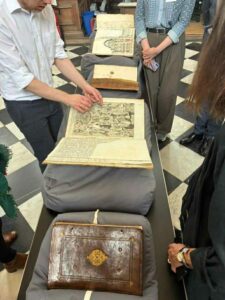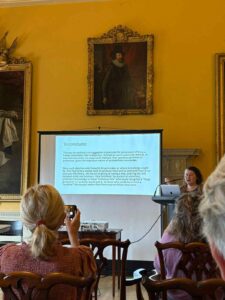The two-day ‘Art-Lovers in the World: Engaging with Art and Matter in Early Modernity’ conference took place at Trinity College, Cambridge on 28 and 29 June. The conference brought together an interdisciplinary group of leading scholars from North America and Europe to discuss the persona of the art-lover and the cultural movement of art-lovers (Kunstliebhaber, liefhebbers, amateurs, virtuosi) in the early-modern world.
‘Art-Lovers in the World’ began with a short introduction given by co-organizer Amelia Hutchinson, who outlined the core aim of the conference to better understand and define the evolving community(-ies) of early modern art-lovers and their practices. Hutchinson emphasized the importance of exploring the rhetorical, commercial, religious, political, and intellectual matrix out of which the distinct persona of the art-lover—and the international community of art-lovers—developed and co-evolved. This framed the conference’s collaborative investigation into the underappreciated role of art-lovers in the social, economic, and intellectual changes which define the early modern period.

The first panel was framed around the question of terminology and conceptualizing art-lovers as a period phenomenon. Claudia Swan began with a talk on art-lovers (liefhebbers) in the Dutch context. Swan examined how the particular sensorial qualities of art objects, in particular those of luster and sheen, brought art-lovers together and, in turn, how art-lovers created a demand and market value for such objects. Indeed, liefhebberij represented what Swan terms a ‘market sensibility’ tied to particular emotions and its own concomitant grammar of sensory impressions. Martin Mulsow spoke about Duke August of Saxe-Gotha at the end of the period, examining how the ‘queer prince’ brought together an intimate community of art-lovers, defined not by fascination (Fazinationsgemeinschaft) per se, but a shared imagination and a passion for creative possibility oriented towards specific syntheses of artistic novelty and exoticism. Mulsow’s talk prompted reflection on who was included in communities of art-lovers? Who, indeed, could be termed an art-lover? And whether this changed according to time and place? The final panelist was Michael Wenzel who examined the use of the German term Kunstliebhaber in the activities of the merchant–diplomat Philip Hainhofer. Wenzel demonstrated how Kunstliebhaber became a confessionally neutral term which elevated art (Kunst) to the level of politics as a means of transcending religious division even during the height of confessionalism, c. 1600.
The second panel turned to market forces and global commerce. Ruth Ezra talked about the use and transformation of global materials in a variety of art objects. Ezra’s focus was on the visual effects of Muscovy glass and other forms of mica and selenite, and how their qualities were appreciated by art-lovers, not just for their rarity, but in natural philosophical terms and the ways they could be manipulated by artists such as Daniel Bretschneider for novel optical effects. Seven Dupre moved on to discuss the role of New Christian merchant elites as art-lovers. Using the example of the Ximines family in Antwerp, Dupre demonstrated the intimate connection between practices of art-loving, experiment, mercantile knowledge, and global trade networks, and the social role played by art-love for elevating new elites, in particular by ‘mobilitating’ merchants. Lisa Skogh ended the panel with a talk on Central European noblewomen—especially dowager princesses—as art-lovers, patrons, and collectors of global and European art objects. Skogh demonstrated how such women attained political agency through their self-representation as art-lovers while asking: what types of knowledge, objects, and materials were deemed appropriate for women art-lovers to know about and experiment with?
Panel three explored the association between art-loving and confessional and political ambiguity. Marika Keblusek discussed the political fluidity of the Dutch art-lover and political agent Joachim de Wicquefort by exploring the different ways he engaged with and mobilized mercantile/artisanal knowledge and humanist learning. In so doing, Keblusek delineated some of the key but subtle differences between the practices of art-loving and late humanism. Christine Göttler turned again to the Ximines family in Antwerp, focusing on Emmanuel Ximines and his circle of friends. Göttler demonstrated how merchant elites promoted the ‘worldly interests’ of art-lovers in a spirit of utopian optimism about how arts and crafts could improve society. Simultaneously, they used art-love to create conditions which served the pragmatic interests of merchants who wanted to conduct business and cooperate across confessional divides. Lastly, Anne Mariss discussed the trans-confessional circulation and reception of rosaries in early modern German and Dutch collections. Mariss demonstrated how the material and technical interests of art-lovers meant that Calvinists and Lutherans, as well as Catholics, collected and appreciated these objects. Indeed, oftentimes rosaries were not classified as religious objects in cabinet collections, but rather according to their particular material, aesthetic, and multi-sensorial qualities.
The first keynote, ‘Colonial Dürer: Art-Loving and the Making of Culture’, was delivered by Ulinka Rublack, who contextualized Albrecht Dürer’s famous 1520 appraisal of Mexican art objects brought back by Hernán Cortés for display in the Brussels Stadhuis. Rublack demonstrated how artists such as Dürer were closely connected with merchants and deeply embroiled in new global markets—participating in and shaping ‘taste communities’ that were sustained by the exchanges of art-lovers. These taste communities were not only responsible for promoting global art objects which demonstrated the ‘subtle ingenuity of foreign hands’, but also the consumption of lucrative commodities such as sugar and silk. Thus the art objects circulated by art-lovers existed alongside certain global commodities within—using Alfred Gell’s terminology—an ‘agentive nexus’ which gave both particular value and meaning during the first stage of globalization.

The final panel was concerned with art-lovers and the new empirical and mechanical philosophies of the late sixteenth and seventeenth centuries. Pamela Smith discussed artisan–authors as promoters of new material and epistemic virtues during the early modern period. She demonstrated how the recipe, arts, and crafts books authored by makers—and of great importance for art-lovers—reveal how the embodied knowledge of craftspeople, ‘material intelligence’, and skills of discernment became personal, social, and epistemic virtues which coalesced around the figure of the art-lover. Davide Martino presented on Albrecht VII of Austria and Ferdinando de’ Medici as water- and art-lovers. Martino extended the discussion of art-lovers to include rulers and engineers who were passionately interested in the hydraulic arts and garden culture. Bold technical projects, practical and ornamental, and the empirical knowledge required to undertake them, were just as important for art-lovers as art objects and rarities. Through such arts, art-lovers envisaged how the world could be transformed and improved. Finally, Elizabeth Petcu presented on Albrecht Dürer’s use of mathematics in his Victoria copper-plate engraving and various other grotesques. Petcu argued that Dürer’s geometrical linear monuments display a grotesque symmetry, signifying his belief in the generative potential of the art of measurement. At once, Petcu argued that Dürer’s grotesques can be read as a learned anti-classicism which cautiously echoed the remonstrances of the 1524–5 German commoner’s rebellion, albeit without explicitly revealing his political sympathies.
The final keynote, given by Vera Keller, discussed ‘“Lovers of Vertue”: Knowledge as Commodity in Interregnum London’. Keller showed how English art-lovers including the educational reformer Sir Balthazar Gerbier and the journalist Henry Walker, among others, framed and marketed their wares and practical knowledge as virtuous and beneficial to the public good. They addressed their audience as ‘lovers of vertue and knowledge.’ In so doing, they resituated emotions such as the love of arts and sciences in seemingly incongruent commercial terms while allowing art-lovers to imagine a shared identity of public moral authority. Bringing the passion of art-love into our understanding of the mid-seventeenth century English knowledge marketplace, Keller demonstrated the entanglement of knowledge and material desire in the advancement of common learning and the spread of the ‘New Science’.

The conference concluded with remarks from Sachiko Kusukawa. Kusukawa framed her comments as key questions, many of which were central to the discussion, that she believes ongoing research on art-lovers need further investigate and refine. Namely, who counted as an art-lover in different places and times, and how was this identity recognized, self-defined, or socially constructed among collectors and connoisseurs? What did art-lovers value and why—how did they assign meaning and emotional or intellectual value beyond material cost? How did they acquire and sustain their objects of desire, through what networks, intermediaries, or commercial and material practices, and how did this extend to care and maintenance, even of living collections such as gardens? Where and when did these practices emerge, and how did geography, provenance, and circulation—especially in mercantile centres such as Antwerp—shape the culture of art-loving? Finally, how did art-lovers connect arts, crafts, and rarities across cultures, and what do imitation, Kunstkammern, and encounters with the Islamicate world (which was not discussed in the conference), as well as the colonial world, reveal about new European emphases on creativity and global exchange?
Frederick Crofts gained his PhD from Jesus College, University of Cambridge and has since held postdoctoral positions at the Zentralinstitut für Kunstgeschichte München, the Herzog August Bibliothek Wolfenbüttel, and the University of Tübingen.